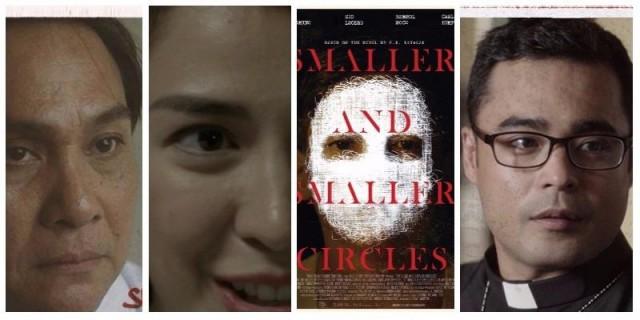'Smaller and Smaller Circles' is required viewing
In "Smaller and Smaller Circles", a serial killer is on the loose in 1990s Manila. The victims are prepubescent boys living in the garbage dump that is Payatas, the skin on their faces peeled away and their genitals cut off. Their corpses are left on top of the trash heap, rotting and maggot-infested.
Enter our heroes: the Jesuit priest Father Augusto “Gus” Saenz (Nonie Buencamino) and his younger colleague Father Jerome Lucero (Sid Lucero). They’re not there to provide spiritual comfort to the grief-stricken families; Father Saenz is also a forensic anthropologist and Father Lucero is a psychologist and university professor. National Bureau of Investigation (NBI) Director Lastimosa (Bembol Roco) asks for their help to crack the case, much to the chagrin of lower-level agent Ben Arcinas (Raffy Tejada).
The film is essentially a murder-mystery; an actual, honest-to-goodness local thriller tackling a serial killer. We haven’t had one of those since perhaps Rory Quintos’s 1996 thriller "Sa Aking Mga Kamay".
But this one has at least one thing going for it that the Aga Muhlach-starrer didn’t.
It’s actually good.
Based on FH Batacan’s Palanca Award-winning novel, "Smaller and Smaller Circles" was several years in the making, and it shows. Despite having an independent production company behind it (Tuko Film Productions and Buchi Boy Entertainment), the film looks and feels lavish.

Credit must go to the production designers and cinematographer J.A. Tadeña who took great pains to recreate the look and feel of Manila in the 1990s as authentically as possible.
The dialogue is realistic, which is impressive, considering how characters from many Tagalog movies speak in the way that nobody in real life ever sounds like.
Here, they speak as regular people: The two priests speak in natural, unaffected English the way you'd hear educators and intellectuals talk, while the Payatas residents in the movie has down pat Manila street language. Even a short conversation in French doesn’t sound pretentious. It’s a generally overlooked aspect of local films that I appreciated.
As Father Gus Saenz, Buencamino admittedly, wasn’t what I expected based on how he was characterized in the novel, but he quickly proved he was up to the task. The veteran actor imbued the detective-priest with grace, elegance, a commanding presence and quiet dignity. It’s now difficult to imagine anybody else in the role.
Sid Lucero’s Fr. Lucero, meanwhile, was smart, thoughtful, and genuinely likeable. There were audible signs of assent in the theater when broadcast journalist Joanna Bonifacio (Carla Humphries) made a crack about Fr. Lucero’s good looks, and for a split second, I half-thought the filmmakers were throwing romance into the mix. Thankfully, it was just that, and if anything, Lucero (the actor) is an effective ambassador of what a modern, progressive priest could actually be.
Although occupying smaller roles, the supporting cast carry their weight in the movie. Particular kudos should be given to Tejada, Roco, Humphries, Ricky Davao as a deliciously menacing Cardinal Meneses, and Christopher De Leon, who, in two scenes as NBI Deputy Director Philip Mapa, reminded us why he’s one of the Philippine’s finest actors.
RELATED: 'Smaller and Smaller Circles' role a dream come true for Carla Humphries
Martin’s direction is generally deft and efficient. He lets the actors and atmosphere do their thing and allows the narrative to run its course. The way he builds tension and the slow burn towards a gripping climax, I would surmise that he took some notes from filmmakers like Alfred Hitchcock and David Fincher.
However, the decision to alter the big confrontation scene near the end (and switch the order of some scenes from how they happened in the book) was puzzling and felt like it took from the gravity of the climactic standoff.
The question on many viewers’ minds is whether they should read the book before going to see the movie. In most cases, I would advocate familiariazing yourself with the source material to more fully appreciate the film. (It’s also more fun to spot how much or how little the movie departs from the original). In this case, I would argue that prior knowledge of the material doesn’t matter as much.
"Smaller and Smaller Circles" may feel like escapist entertainment in some ways, but it also feels essential and immediate. The film is required viewing for anyone concerned about where we are and compare it to where we were.
It has things to say about current events in Philippine society that mirror the social issues that Batacan put forth when the book was first published in the 90s. Religion, income inequality, government ineptitude, sexual assault — the list goes on, and all of them still ring true and are just as timely today as they were 20 years ago. — LA, GMA News



